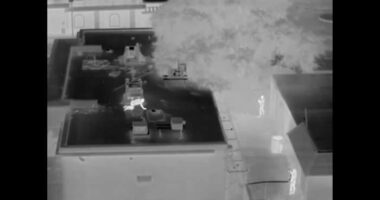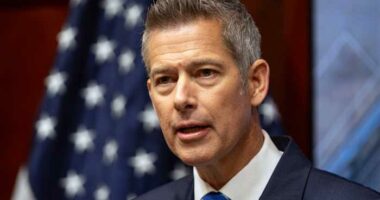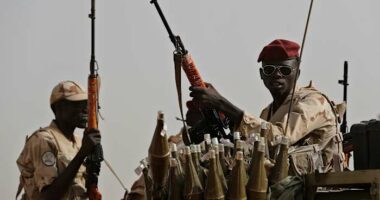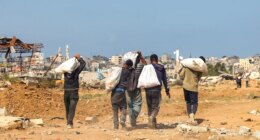Share this @internewscast.com

Authorities have identified a man accused of shooting two National Guard members in Washington as one of approximately 76,000 Afghans who were relocated to the United States following the tumultuous U.S. withdrawal from Afghanistan amid the Taliban’s resurgence.
This relocation was part of Operation Allies Welcome, an initiative launched after the 2021 decision to exit Afghanistan. This exit marked the end of two decades of American involvement and substantial financial support in the region.
President Joe Biden, a Democrat, who managed the withdrawal process initiated by his Republican predecessor, Donald Trump, emphasized the U.S.’s responsibility to provide refuge to interpreters, translators, fighters, drivers, and others who stood against the Taliban regime, ensuring their safety outside of Afghanistan.
However, critics, including Trump and numerous Republican figures, have argued that the resettlement process was poorly executed, resulting in inadequate vetting of the refugees, mirroring the chaos of the U.S.’s withdrawal from Afghanistan.
CIA Director John Ratcliffe criticized the situation, stating, “This individual—and countless others—should never have been granted entry. Our citizens and service members deserve better than to face the repercussions of the Biden Administration’s monumental missteps.”
Notably, the accused shooter had previously collaborated with the CIA before seeking refuge in the United States.
The accused shooter, identified by law enforcement officials as Rahmanullah Lakanwal, worked with the CIA “as a member of a partner force in Kandahar,” Ratcliffe said in a statement Thursday. It didn’t specify what Lakanwal did for America’s spy agency.
The Kandahar region in southern Afghanistan was in the Taliban heartland of the country and saw fierce fighting between the Taliban and NATO forces after the U.S.-led invasion in 2001 following the al-Qaida attacks on Sept. 11. The CIA relied on Afghan staff for translation, administrative and front-line fighting with their own paramilitary officers in the war.
Little is known about Lakanwal’s four years in the U.S. or why he drove across the country from his home in Bellingham, Washington, where a former landlord said he lived with his wife and five children.
Lakanwal was granted asylum in April under the Trump administration, according to #AfghanEvac, a group of veterans and others working to get Afghans who helped the U.S. out of the country in exchange for their help.
Like all asylum seekers, he would have had to undergo fingerprinting and iris scans, a full background check and interview and a risk assessment, the organization said.
Operation Allies Welcome brought tens of thousands of Afghans to the US
Groups that help resettle Afghans said the actions of one man shouldn’t reflect negatively on the tens of thousands who have gone through the various legal pathways to resettling in the U.S. and the others who find themselves in limbo after Trump suspended almost all resettlement programs for nations across the world when he took office in January.
“I don’t want people to leverage this tragedy into a political ploy,” said Shawn VanDiver, president of #AfghanEvac.
After leaving Afghanistan, tens of thousands of those seeking resettlement ended up in sprawling air-conditioned tent villages at military bases like Joint Base McGuire-Dix-Lakehurst in central New Jersey, Fort McCoy in Wisconsin or at Fort Bliss in Texas.
After months of health screenings and background checks many were resettled in established Afghan communities in northern Virginia and the surrounding Washington area, as well as Northern California and Texas. States where between 1,000 and 3,000 have settled include Arizona, New York, Florida, Georgia, Colorado, Nebraska and Pennsylvania, according to State Department data.
Trump stops aid for resettlement after taking office
Trump’s executive order shortly after taking office in January suspending federal funding for resettlement agencies made it tougher to help refugees with basic necessities like food and rent handcuffing the mostly religious groups that help them.
The president, who has described Afghanistan as “a hellhole on earth,” already planned to review every Afghan who entered the country under Operation Allies Welcome and reiterated that goal after Wednesday’s shooting.
“If they can’t love our country, we don’t want them,” Trump said in a message released on social media, adding that the shooting was “a crime against our entire nation.”
Trump administration wants to shut the door to most refugees
Trump also used his message to attack refugees from Somalia who have settled in Minnesota, saying they are “ripping apart that once-great state.”
It’s part of this administration’s goal both to deport people in the country illegally and close the country to most refugees. Trump said he wants to remove anyone “who does not belong here or does not add benefit to our country.”
One of the Afghans who made it to the U.S. was Mohammad Saboor, a father of seven children, worked as an electrician and A/C technician with international and U.S. forces for 17 years. He resettled earlier this year in California and told The Associated Press he looked forward to sending his kids to school and giving back to the country that took his family in.
“I believe that now we can live in a 100% peaceful environment,” Saboor said.
___
Associated Press journalists Eric Tucker and Martha Bellisle contributed.
Copyright 2025 The Associated Press. All rights reserved. This material may not be published, broadcast, rewritten or redistributed without permission.












